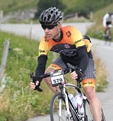My informal study of Eddy Merckx continues and he is just getting more and more unbelievable. Today's lesson is the French expression, 'la course en tête', which, when paired with the verb 'faire', means to 'lead the field'. When used in cycling terms it translates roughly to 'Eddy Merckx'.
If you have watched any pro cycling, and paid some attention to it, you will know that nearly all races follow a similar recipe: race-day favorites stay hidden behind trusty domestiques, till they determine that it's their time to attack (or wait for another favorite to attack and follow). Like this.

Big names keeping a low profile
Eddy Merckx played a more aggressive game. He nearly always rode at the front of the peloton, or near it at least. There are stories of other riders trying to lull him to the back of the pack by chatting, just to see if they could, but at a certain point he would get concerned and go back to the front. It was his place.
He had domestiques, of course, but he often rode at the very front, pushing the peloton and making his rivals suffer. The idea is not unfamiliar today because this is what teams often do to limit the chance of attacks (it being harder to attack when the speed is high). The difference is that, for example, Movistar, will do this at the front of the pack for Valverde or Quintana, but it won't be those guys doing the damage till all the domestiques are used up. In Eddy's case, he was often the 'damager'. He did this on mountain stages often because there were riders who were better climbers than him. His strategy of la course en tête was employed to wear these lightweights down before the climbing started. Once the attack came, he could just up the pace a bit and the slow (but inevitable) catch began, since most of the juice had been sucked out of his rival's legs already.
He would also attack, of course, and the number and length of these exploits are legendary. The most audacious was on Stage 17 of the 1969 Tour de France when, already 8 minutes ahead on the GC, he attacked on the top of the first climb of the day (Tourmalet) and rode 140 km solo to the victory, gaining another 8 minutes on his nearest rival.
Watching video of Eddy Merckx today you might ask yourself why nobody in the pro ranks adopts his way of riding, since it was obviously so successful. The answer, of course, is that nobody is, or has ever been, as strong, smart or determined, as Merckx. But more on that next time.
0 Comments





